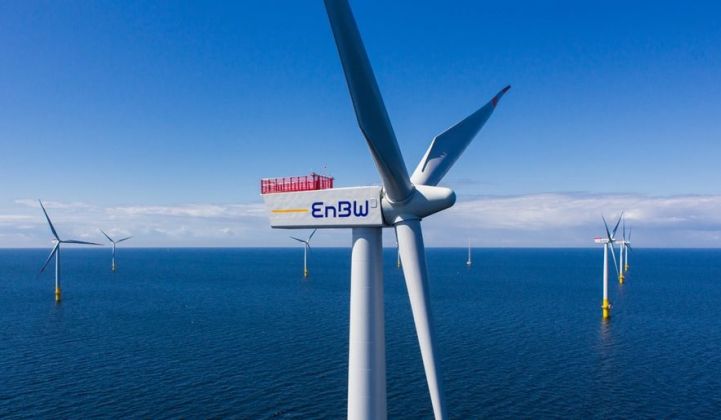The European Union’s two biggest economies, Germany and France, both supercharged their offshore wind ambitions this week.
Germany on Wednesday passed a new 2040 target of 40 gigawatts and boosted its interim 2030 target from 15 gigawatts to 20 gigawatts. Germany already has the world's second-largest volume of grid-connected offshore wind (7.5 gigawatts), behind only the U.K.'s 9.9 gigawatts, according to data from the Wind Europe trade body.
The German government also announced a strategy with network operators to help it expand its offshore wind capacity. The deal includes streamlining the permitting process and creating a timetable for necessary grid reinforcements that run in parallel with the project pipeline. Germany’s wind-rich north and solar-rich south often pose challenges for the grid, with negative pricing a frequent occurrence.
The new offshore wind bill was passed on the same day that Germany pushed through its economic stimulus package. The most notable change from the country's package from 2008 was the absence of incentives to buy cars from the nation's auto giants — unless, that is, they are electric vehicles.
The European Commission estimates that Europe will need at least 230 gigawatts of offshore wind by midcentury, and perhaps as much as 450 gigawatts, to support its planned electrification and decarbonization efforts. To get there from today’s base of 12 gigawatts (which excludes the U.K.), Europe will need the support of its two economic powerhouses.
France’s homegrown strategy pays off
France has long been an offshore wind laggard compared to the U.K. and Germany, but things finally look set to change.
This week Siemens Gamesa booked an offshore turbine order just short of 1 gigawatt for the Fécamp (EDF, Enbridge, wpd) and Saint-Brieuc (Iberdrola) projects. The blades and nacelles for both will be made at a new factory in Le Havre on the Brittany coast. GE also makes its offshore wind turbines in France.
Siemens Gamesa, the world's leading offshore wind turbine maker, claims to have another 1,500 megawatts of French orders ready to close at Courseulles-sur-Mer, Dieppe le Tréport and Yeu Noirmoutier projects.
Meanwhile, Total, France's oil major, ramped up its investments in offshore wind, announcing its first major investment in the sector this week. Total acquired a 51 percent stake in the 1,075-megawatt Seagreen 1 project being built off the coast of Scotland by SSE Renewables.
Earlier this year Total acquired an 80 percent stake in a 96-megawatt floating wind project in U.K. waters, but Seagreen represents its first investment into a technologically mature, utility-scale project.
Total will pay SSE £70 million ($88 million) when the Seagreen deal closes and up to £60 million more based on the project’s performance.
Total is aiming for 25 gigawatts of renewable generation capacity by 2025. In its most recent results, the company revealed that it currently has 3 gigawatts of operational renewable. It has added almost 7 gigawatts to its renewable energy pipeline in 2020 with deals in Spain, India, France and Qatar. That leaves it with another 15 gigawatts to find during the next four and a half years.
Seagreen developers embrace market risk
Seagreen 1 has a contract for difference (CFD) with the U.K. government for £41.61 per megawatt-hour. But this only covers 454 megawatts of the project’s capacity. SSE said in a statement that it would take 30 percent to market itself, potentially via corporate power-purchase agreements, a relative novelty for offshore wind, for now.
“SSE and Total might use any remaining energy, after CFD output and SSE’s offtake, to sell to other offtakers and/or might want to take market risk,” said Tom Harries, head of wind research at Bloomberg New Energy Finance, in an emailed statement. “Market risk is obviously riskier than getting a fixed price for your power, but if you think future prices might be higher than the fixed prices on offer, then holding some back could lead to higher profits. It's a game of risk and reward,” said Harries.
Momentum in the German and French offshore wind sectors comes amid concerns over other European markets.
The U.K. government has delayed approval of 6 gigawatts of new capacity, and on Tuesday it rejected plans for a 340-megawatt extension to the existing Thanet project. Swedish developer Vattenfall warned that further holdups could threaten the country’s plans to install 40 gigawatts by the end of this decade.
Meanwhile, the latest Dutch tender passed in April, with German utility EnBW and Vattenfall, a previous winner, opting to sit it out. Shell and Ørsted both entered bids linked to the production of green hydrogen.



